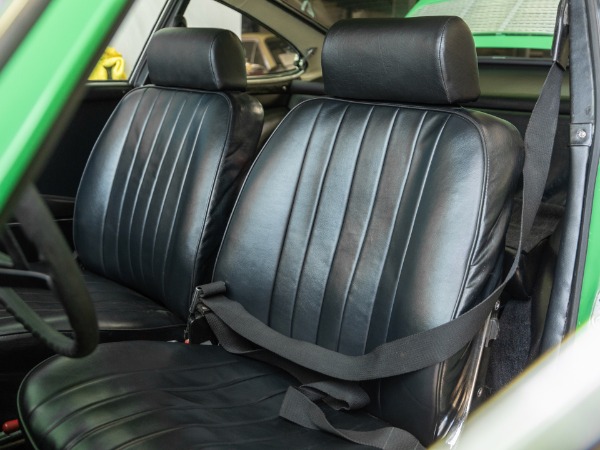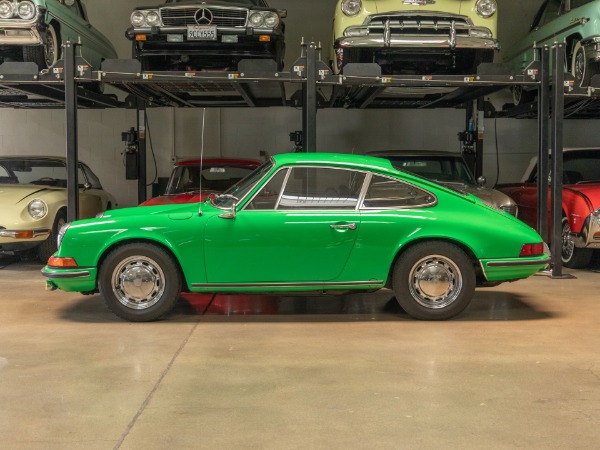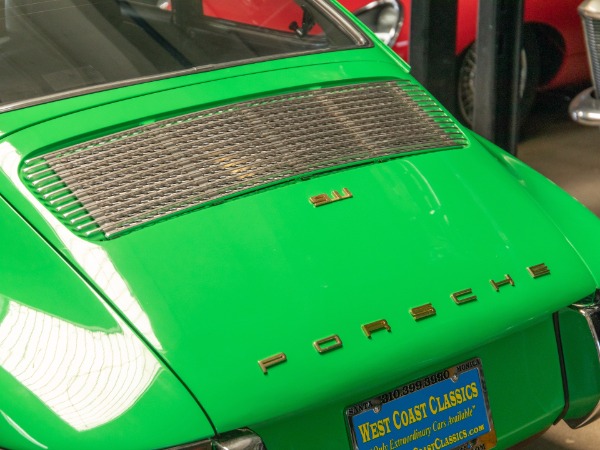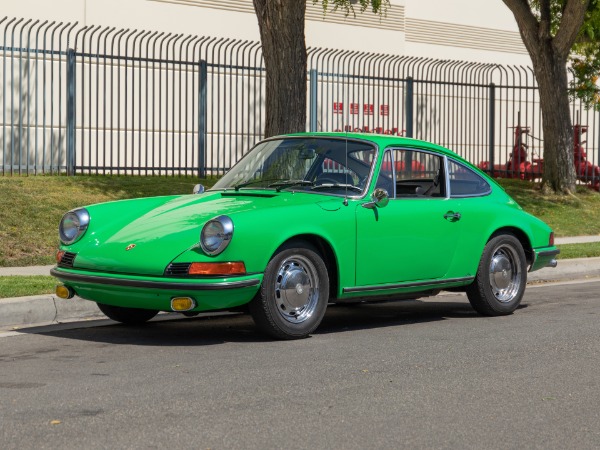1971 PORSCHE 911T KARMANN COUPE
Known for its iconic design and exceptional performance, the Porsche 911 is one of the flagship models from the esteemed German automaker, Porsche AG. Since its debut in 1963, the 911 series has consistently evolved, becoming a symbol of automotive excellence while preserving its core characteristics.

In 1971, the Porsche 911 series experienced several enhancements, giving birth to several unique models, including the notable Porsche 911 T, or “Touring.” This vintage model is a testament to Porsche’s ability to innovate and redefine the sports car landscape. The 1971 Porsche 911 T embodies the classic 911 shape with its aerodynamic body, sloping hood, and pronounced wheel arches, all accentuating the vehicle’s rear-engine layout. The compact design and 2+2 seating capacity combine style, sportiness, and practicality in a unique blend that is the trademark of the 911 series.
The 1971 Porsche 911 T was known for its performance and handling characteristics that were a result of its unique design and engineering. Let’s delve into more details about its specifications and engine.
Engine Specifications:
The 1971 Porsche 911 T was powered by a naturally aspirated 2.2-liter air-cooled flat-six engine located at the rear. This was an evolution of the 2.0-liter flat-six used in earlier models. The engine featured two valves per cylinder, with a single overhead camshaft (SOHC) for each cylinder bank.
In the U.S. model, the 911 T used a mechanical fuel injection (MFI) system, which helped it to meet stricter emission standards. Models sold in other markets, however, used twin Weber carburetors. This engine produced approximately 125 horsepower (93 kW) and around 130 lb-ft (176 Nm) of torque.
Transmission:
The 911 T was equipped with a five-speed manual transmission known as the “901 transmission”. It used a dog-leg shift pattern, where the first gear was down and to the left, which was somewhat unusual but favored in a racing-style layout as it allows for easier shifting between the more commonly used gears.
Chassis & Suspension:
The chassis of the 911 T was designed with a unibody structure, providing more rigidity and less weight compared to traditional body-on-frame designs. The suspension was independent at all four corners. The front suspension was a MacPherson strut setup, while the rear used a semi-trailing arm system. This setup, along with the rear engine placement, contributed to the 911’s unique handling characteristics.
Brakes & Tires:
The 1971 Porsche 911 T was fitted with disc brakes on all four wheels, which were vented to provide better heat dissipation and overall braking performance. The tires were radial ply, providing improved handling and ride comfort compared to the bias-ply tires that were common at the time.
Dimensions:
The 911 T, like other 911 models of the time, had a wheelbase of 89.4 inches (2271 mm), a length of 163.9 inches (4163 mm), a width of 63.4 inches (1610 mm), and a height of 52 inches (1321 mm). Its curb weight was approximately 2,381 lbs (1080 kg), which was relatively light and contributed to its lively handling characteristics.
In summary, the 1971 Porsche 911 T represented a balance of performance, handling, and practicality. It was a result of Porsche’s continuous development of the 911 line, and its design and engineering decisions played a crucial role in shaping the identity of future 911 models.
The 911 T model introduced to the United States incorporated a mechanical fuel injection system (MFI) to meet the strict emission regulations of the period. In contrast, models marketed in other regions retained the Weber carburetors. A five-speed manual transmission facilitated impressive control and driving engagement, a standout feature for sports cars of that era.
The suspension system of the 1971 Porsche 911 T incorporated MacPherson struts at the front and a semi-trailing arm setup at the rear. Combined with the car’s rear-engine layout, this delivered unique handling characteristics synonymous with the 911 T.
The 1971 enhancements brought a boost in power and a shift from a short to a long wheelbase, which had been incorporated in 1969 to augment the car’s handling dynamics. The 911 T also received an upgraded brake system, swapping solid discs with vented ones for improved performance and heat dissipation.
While maintaining the typical minimalist interiors common with sports cars of its era, the 1971 model introduced superior-quality materials and improved soundproofing.

Over the years, the 911 T evolved alongside the rest of the 911 lineup, benefiting from the same advancements in technology and design. The 911 T’s engine displacement increased over time, and it received the same significant updates as the other models, like moving from a short wheelbase to a long wheelbase in 1969 to improve handling.
Key contributors to its timeless design include Ferdinand Alexander “Butzi” Porsche, Erwin Komenda, and Ferdinand Piëch. Ferdinand Alexander “Butzi” Porsche, the son of Ferry Porsche and the grandson of Ferdinand Porsche – the company’s founder, played a pivotal role as the chief designer of the Porsche 911 project. His vision resulted in a stylish and timeless design that remains distinctly visible in today’s 911 models. Butzi Porsche is credited for the sleek, aerodynamic design, and the instantly recognizable silhouette of the 911.
Erwin Komenda, an Austrian car designer, significantly contributed to the body design of the Porsche 911. Having collaborated with Ferdinand Porsche prior to the inception of the Porsche car company, Komenda influenced the early designs of Porsche vehicles. He was chiefly responsible for the innovative monocoque (unibody) structure of the 911, an advanced design that offers superior rigidity and lower weight compared to traditional body-on-frame designs.
Ferdinand Piëch, another grandson of Ferdinand Porsche, brought his expertise as a mechanical engineer to the development of the six-cylinder engine for the 911 during his tenure as head of the technical department. Piëch later ascended to the position of chairman of the Volkswagen Group.
Porsche’s relationship with Karmann began in the early years of the Porsche 911. Due to high demand for the 911 model and capacity constraints at Porsche’s Stuttgart-Zuffenhausen factory, Porsche contracted with Karmann to help manufacture the 911. Karmann produced bodies for the Porsche 911 from 1965 until 1974. These bodies were then transported to Stuttgart, where they were painted and fitted with engines and interiors. The “Karmann Notch,” a slight indentation on the top side of the front fender just rearward of the headlamp, is a notable feature on early Porsche 911s and 912s produced by Karmann.
OUR 1971 Porsche 911T Karmann Coupe
‘We take immense pride in presenting an exemplary specimen of the 1971 Porsche 911T 2.2L 6-cylinder Karmann Coupe. This car stands out for its virtually all-original and stock condition. It features an original black interior, a matching numbers stock 2.2L engine, the factory’s original ‘Conda Green’ color, and a 4-speed manual transmission.
Complete with original documentation from the initial selling dealer, including owner’s manuals and its Porsche Certificate of Authenticity, this car is a gem in the classic car world. To fully appreciate its charm and performance, one must experience it firsthand. The renowned original 2.2L Porsche engine, noted for its power and reliability, is in excellent condition. The 4-speed manual transmission offers smooth shifting without any synchro issues, and the engine maintains a cool temperature during operation.
With the unveiling of the ‘C’ series, the 4th edition of the 356 model in 1964, anticipation was high for Ferdinand ‘Butzi’ Porsche’s next creation, which would become the iconic 911. While the new Porsche retained a rear-engine and unibody chassis, similarities with its predecessor ended there. The new model boasted a smooth air-cooled 2.0L flat six-cylinder engine, replacing the former four-cylinder, and was coupled with a 4 or 5 speed all-synchromesh transmission.
The new 911 model was introduced at the Frankfurt Auto Show in September 1963, initially under the name Porsche 901, with a limited 82 models produced in 1964. However, due to French automaker Peugeot’s prior claim on three-digit model names with zero in the middle, Porsche renamed the 901 to the now legendary 911. Consequently, the approximately 150 models produced in late 1964 were introduced as 1965 models and rebranded as the new 911. Despite these early naming complications, the 911 quickly surpassed its 356 predecessor, offering a timeless design that has continued to captivate and influence the automotive world.’

Today, the 1971 Porsche 911 T is a coveted classic, drawing the attention of collectors and Porsche enthusiasts alike. Its exciting performance, iconic design, and the respected reputation of the 911 series contribute to its ongoing demand. The model signifies the end of an era with its 2.2L engine, as Porsche transitioned to a 2.4L engine in 1972. This blend of original design ethos and progressive enhancements secures the 1971 Porsche 911 T a distinctive place in the rich history of the 911 series.
Looking to simply value or sell, trade or consign your classic 1971 Porsche 911T? We can help. 310-399-3990 or info@westcoastclassics.com

